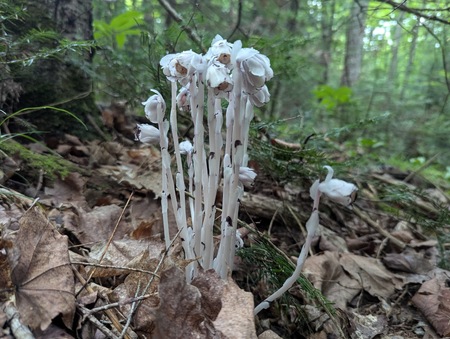
Good Natured: Ghost Pipes
A few weeks ago I had the opportunity to head north, to the forested lands of Gogebic County in Michigan's Upper Peninsula. It's not all that far away, under six hours if you hit the Wisconsin construction zones just right. But, I tell you, walking across those Michigan granite outcrops, amid the lush ferns and beneath the mixed hardwood and conifer canopy, I might just as well have landed on another planet. I tell you, nothing—NOTHING—looked even remotely familiar.
Take for instance sugar maples. Now, this is a tree that I learned to identify waaay back in junior high school. I remember our science teacher, Mr. Slavik, taking us on a walking field trip to learn about the urban tree canopy, and pointing out a particularly fine sugar growing in a nearby yard. Besides the shape of the leaves and the tree's branching structure—opposite, as opposed to alternate—he ran his hand along the brown bark and described it as furrowed, sometimes tinged in salmon.
Northwoods sugar maples, however, are anything but. Instead of furrowed, the bark is flaky. Rather than brown, it's gray. No salmon highlights either, although many in the deeper woods were adorned with moss and lichens.
Pine, spruce and fir— seen only as specimen trees here in IL—alternated with the maples, birch and aspen. The forest floor's herbaceous layer featured those aforementioned ferns plus other lovelies including blue-bead lily (Clintonia borealis) and bunchberry dogwood (Cornus canadensis).
Happily, there was not even one sprig of Alliaria petiolate, garlic mustard, the plant restoration ecologists love to hate.
Although I was staying in an off-grid cabin there was, believe it or not, an intermittent cell signal, which allowed me to access to several online plant identification websites. I spent a couple of evenings poring over what I'd seen during the day, applying names to photos and trying my best to sort out the astounding biodiversity despite having left my field guides at home.
Things were a little bit easier during a hike along a gravel road, where the sun shone brightly and old friends grew. I quickly recognized spotted Joe-Pye weed (Eutrochium maculatum) and wild strawberries—the good kind, Fragaria, as opposed to the crummy mock strawberry (Duchesnea indica) that predominates in Kane County.
By the next-to-last day I was beginning to feel pretty good about the plants that surrounded us. With some rudimentary IDs under my belt, I could start looking more closely at things like pollinators and other faunal associations. What sort of animals might these plants attract?
I wish I could launch into a list of those species and describe the delightful interactions we witnessed, but two things happened. One, it stormed. Hard enough in fact that it chased even a die-hard rain lover like me back indoors. And two, when we did go back out, I found a plant so storied, so legendary, I outright stopped trying to identify anything else.
Ghost pipes. Monotropa uniflora.
They were growing a couple feet off the trail, amid a well-spaced group of fir seedlings. Their stark-white color made them impossible to overlook and their nodding flowers drew me in, just as their enchanting name suggests they would.
Ghost pipe, which also goes by the common names Indian pipe and corpse plant--a reference to its pale, waxy coloration as well as the way it shrivels and blackens after blooming--isn't the sort of plant you see every day, either in MI or IL. Up north its C-value, or coefficient of conservatism, basically its tolerance to human disturbance, is 5, while here in Kane County it's 10—as conservative as they come.
Our own storied, legendary naturalist, the late Dick Young, describes the plant in his book Wild Plant and Natural Areas of Kane County as “rare" and “one of the most delightful plants we have. Lacking chlorophyll and feeding on soil fungi, these little cameos, with their waxy, white stalks and abbreviated leaves are crowned by pristine, nodding, late-summer blossoms, and as saprophytic spermatophytes they aptly confirm how intriguing and versatile life forms can be."
Wow! That's a lot to unpack.
The key takeaways are that, even though it's a plant, and reproduces by making seeds, ghost pipe doesn't make its own food. It relies on hardworking mycelia—the root-like strands of fungi—to digest organic matter in the soil around it. The ghost pipe, or pipes, as there's rarely only one, then taps into this nutrient source with its roots. (Another, more recently coined term for this relationship is mycoheterotrophy, compiled from the Greek words for fungus, different and nutrition.)
We saw an awful lot of new things on this north-country adventure; in fact I'm still going over pictures and trying—unsuccessfully, for the most part—to put names to the mosses, lichens and those gosh-darn ferns. But I never thought I'd see a ghost.
Pipe.
Now to see if I can find one here.
Pam Otto is the outreach ambassador for the St. Charles Park District. She can be reached at potto@stcparks.org.

